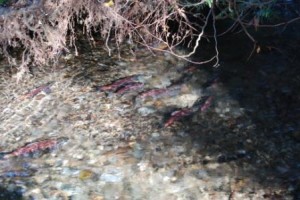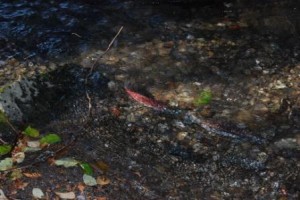
Hundreds of Kokanee females lay their eggs as they return to Moran Creek, thus ending their life cycle. Photo courtesy of Jim Schuh.
The Kokanee are running in Moran Creek at the State Park. The large numbers of returning fish show that the three-year project has achieved success in nurturing disease-free salmon, and in producing a fresh stock of eggs to supply to other hatcheries, thanks to cooperation between the State Fish and Wildlife Department, Friends of Moran State Park and Long Live the Kings salmon restoration organization.
This week, visitors to the Park can see mature Kokanee returning upstream to Moran Creek waters and spawning, thus completing their life cycle. Recently, Park Ranger Kinnan Murray and Friends of Moran Park Michel Vekved gave a tour, explaining the natural yet marvelous success of this freshwater salmon project.
The Kokanee are land-locked salmon, a pure freshwater species. For years, the State Department of Fish and Wildlife has been planting full-grown stock in Cascade Lake for sports fishermen to catch.
Six years ago Moran Park embarked on its own hatchery process, beginning with eggs obtained from Lake Whatcom, near Bellingham, from Fish and Wildlife. When they had grown to a viable size they were released into Cascade Lake from a creek at the south end of the lake.
Three years ago, the Orcas Island Chamber of Commerce information booth in Moran Park was converted into a small hatchery lab. There the eggs have been reared to small “fry” before being released into nearby Moran Creek. During that process, they fry been closely monitored for diseases. Water in the hatchery where the eggs grow into 3-inch long fry comes from water taken and then put back into Moran Creek, via a by-pass dug several years ago.
Last year, from 80,000 eggs, at least 70,000 fry were introduced into Cascade Lake. This year, over 50,000 eggs were harvested from Moran Park Kokanee in the process of determining if they were healthy or diseased. Once again, it was determined that the eggs from Cascade and Mountain Lakes were disease-free (as they have been over the last three years) and may be used for distribution to other hatchery and stocking projects.

Kokanee return upstream to lay eggs at end of life cycle that started at Moran Creek Hatchery. Photo courtesy of Jim Schuh.
This is a hopeful development as there is some concern that eggs from Whatcom Falls may be negatively impacted should a waterway be opened up from Lake Whatcom, as is currently planned.
This year, the Moran Park Kokanee have returned in numbers greater than at any time in the past. Park Manager Jim Schuh has said that in his 13 years at Moran Park he has never seen a return of this size. Within 50 yards of the creek on the lakeside of the road, Murray estimates there are 300 to 500 fish spawning, thus completing their three- to four-year life cycle.
The project has been a partnership between the State Parks and the Department of Fish and Wildlife, which has funded fish food and disease prevention. Mike O’Connell of Long Live the Kings has also provided assistance.
The Friends of Moran State Park have provided the infrastructure for the hatchery and the project, contributing a total of $13,500.
The hatchery fish are solely for the public benefit in recreational use. All parties concerned hope that Cascade and Mountain Lake can become self – sustaining in their production of Kokanee, and not have to rely on eggs from Lake Whatcom, or from larger fish stocked by Fish and Wildlife as they have in years past.
**If you are reading theOrcasonian for free, thank your fellow islanders. If you would like to support theOrcasonian CLICK HERE to set your modestly-priced, voluntary subscription. Otherwise, no worries; we’re happy to share with you.**







